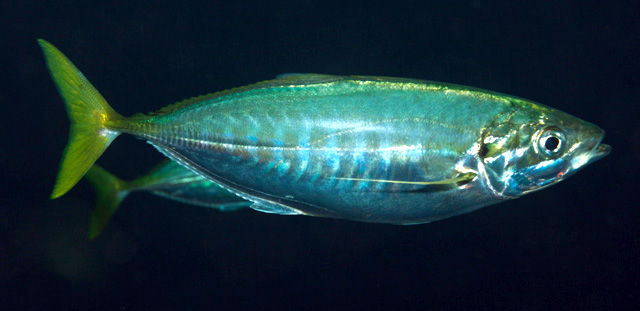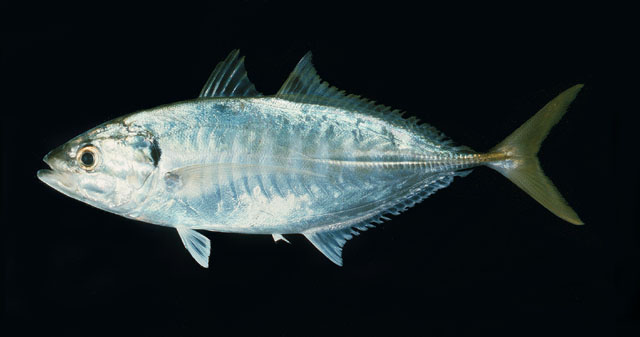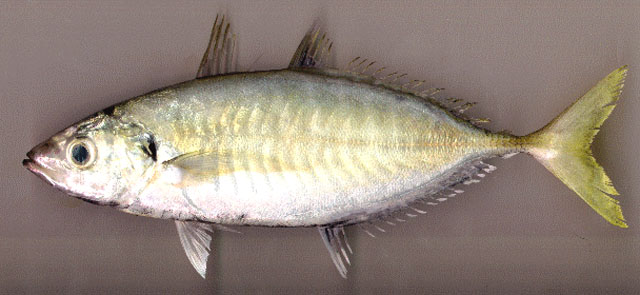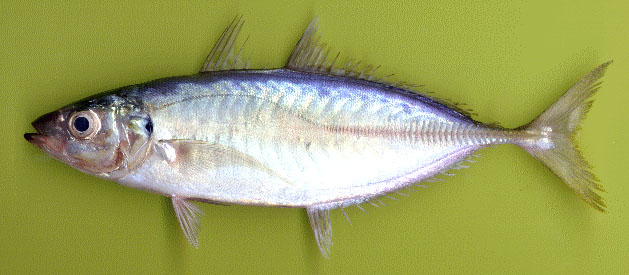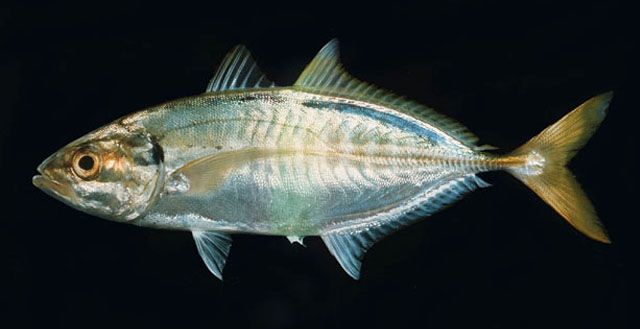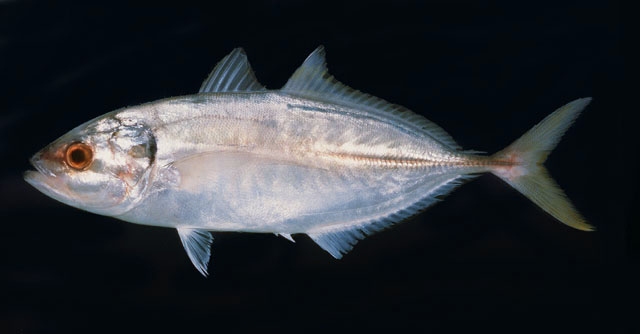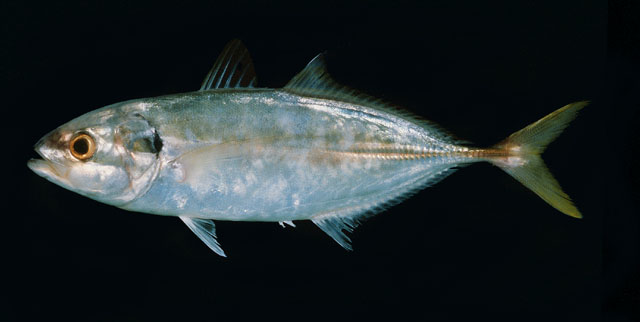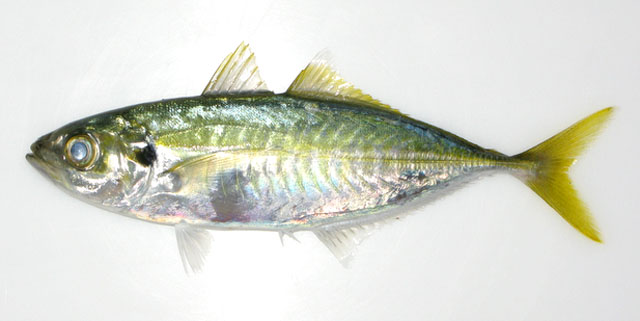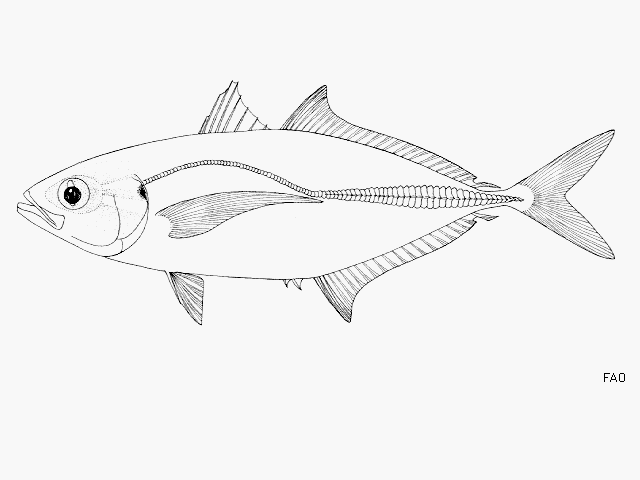Atule
mate
(Cuvier,
1833)
Yellowtail scad
View all media / Upload your photos and videos
Expand all
Classification / Names
Teleostei (teleosts) > Carangiformes (Jacks) >
Carangidae (Jacks and pompanos)
> Caranginae
More on author:
Cuvier.
Environment / milieu / depth range / climate zone / distribution range
Marine; brackish; reef-associated; depth range 1 - 80 m (Ref. 58302); tropical; 35°N - 35°S24°E - 135°W.
Distribution
Maps

Atule mate / Native range
AquaMaps Data sources:
GBIF
OBIS
This map was computer-generated and has not yet been reviewed.

Atule mate / Suitable habitat
AquaMaps Data sources:
GBIF
OBIS
This map was computer-generated and has not yet been reviewed.

Atule mate / Point map
AquaMaps Data sources:
GBIF
OBIS
This map was computer-generated and has not yet been reviewed.

Atule mate / Year 2050
AquaMaps Data sources:
GBIF
OBIS
This map was computer-generated and has not yet been reviewed.
Length at first maturity / Size / Weight / Age
Short description
Dorsal spines (total): 9; Dorsal soft rays (total): 22 - 25; Anal spines: 3; Anal soft rays: 18 - 21. This species is distinguished by the following characters: adipose eyelid well developed and completely covering eye except for a vertical slit centred on pupil; shoulder girdle (cleithrum) margin smooth, without papillae; terminal dorsal and anal rays finlet-like in adults, about twice length of adjacent rays and a little more separated but joined by interradial membrane; lateral line gently arched anteriorly, with junction of curved and straight parts below vertical from sixth to eighth soft rays of second dorsal fin; scales in curved part of lateral line 39 to 57; straight part with 0 to 10 scales and 36 to 49 scutes; a black spot, slightly smaller than eye, on upper margin of opercle and adjacent area of shoulder; dorsal and caudal fins dusky greenish yellow; anal fin pale yellow (Ref. 9894). Description: Body olive green dorsally, shading to white or silvery ventrally; prominent black spot posteriorly on opercle at level of upper eye; often with 10 dark bars on side of body; dorsal and caudal fins dusky greenish yellow (Ref. 2334, 90102). Body oblong, moderately compressed, with dorsal and ventral profiles almost evenly convex. The adipose eyelid completely covering the eye except for a vertical slit centered on pupil. (Ref. 90102)
Biology
Adults inhabit mangroves and coastal bays in pelagic waters (Ref. 58302). They form schools to about 50 m in inshore waters (Ref. 9894), or singly (Ref. 48635). Are mainly diurnal. They feed mainly on crustaceans and planktonic invertebrates such as copepods, including cephalopods (Ref. 5213, 90102). They swim fast in midwater in pursuit of zooplankton (Ref. 48635).
Main reference
Paxton, J.R., D.F. Hoese, G.R. Allen and J.E. Hanley 1989 Pisces. Petromyzontidae to Carangidae. Zoological Catalogue of Australia, Vol. 7. Australian Government Publishing Service, Canberra, 665 p. (Ref. 7300)
IUCN Red List Status (Ref. 125652)
Least Concern (LC); date assessed: March 06 2015
CITES (Ref. 131153)
Not Evaluated
CMS (Ref. 116361)
Not Evaluated
Threat to humans
Harmless
More information
- Countries
- FAO areas
- Ecosystems
- Occurrences
- Introductions
- Stocks
- Ecology
- Diet
- Food items
- Food consumption
- Ration
- Common names
- Synonyms
- Metabolism
- Predators
- Ecotoxicology
- Reproduction
- Maturity
- Spawning
- Spawning aggregation
- Fecundity
- Eggs
- Egg development
- Age/Size
- Growth
- Length-weight
- Length-length
- Length-frequencies
- Morphometrics
- Morphology
- Larvae
- Larval dynamics
- Recruitment
- Abundance
- References
- Aquaculture
- Aquaculture profile
- Strains
- Genetics
- Allele frequencies
- Heritability
- Diseases
- Processing
- Mass conversion
- Vision
- Pictures
- Stamps, Coins Misc.
- Sounds
- Ciguatera
- Speed
- Swim. type
- Gill area
- Otoliths
- Brains
Estimates based on models
Preferred temperature (Ref. 123201): 23.8 - 29.1, mean 28 °C (based on 2048 cells).
Phylogenetic diversity index (Ref. 82804): PD50 = 1 [Uniqueness, from 0.5 = low to 2.0 = high].
Bayesian length-weight: a=0.01349 (0.01204 - 0.01511), b=2.96 (2.93 - 2.99), in cm total length, based on LWR estimates for this species (Ref. 93245).
Trophic level (Ref. 69278): 4.2 ±0.5 se; Based on diet studies.
Resilience (Ref. 120179): High, minimum population doubling time less than 15 months (K=0.58-1.00; Fec=63,000-161,000 (batch fecundity)).
Fishing vulnerability (Ref. 59153): Low vulnerability (18 of 100).
Climate vulnerability (Ref. 125649): Moderate to high vulnerability (47 of 100).
Price category (Ref. 80766): Medium; Very questionable: based on ex-vessel price for species in this family.
Nutrients (Ref. 124155): Calcium = 79.4 [45.4, 166.2] mg/100g; Iron = 1.04 [0.59, 1.83] mg/100g; Protein = 20 [19, 21] %; Omega3 = 0.193 [0.120, 0.326] g/100g; Selenium = 33.1 [17.7, 62.5] μg/100g; VitaminA = 87.6 [28.1, 279.3] μg/100g; Zinc = 1.17 [0.79, 1.61] mg/100g (wet weight); based on nutrient studies.

